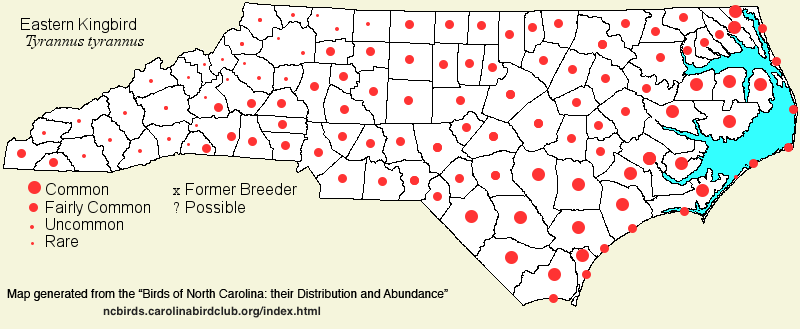 |  |
|
Eastern Kingbird - Tyrannus tyrannus TYRANNIDAE Members: | Search Common: Search Scientific: |
|
|
|||||||
| General Comments | The Eastern Kingbird is another flycatcher that nests in essentially every county in the state -- and its breeding range not only covers the eastern half of the United States, but it also extends well into western Canada, though avoiding the southwestern portions of the States. As with almost all other eastern flycatchers, it completely departs the United States in winter, yet there are numerous reports of the species on CBC's. Essentially all of these reports were made by inexperienced observers, never to hang around to be confirmed visually by experienced birders, nor being photographed. This is all the more blatant in that the species is practically never seen in North Carolina after mid-Oct and before late Mar. Eastern Kingbirds have slowly declined over its range, and it no longer can be called a common breeding species across the state. Breeding habitats always contain much open country, as well as some trees for placing a nest. Favored habitats include farmyard groves, margins of open woods near fields, and very open stands of trees -- all preferably with some water in the territory (pond or lake margin, etc.) | ||||||
| Breeding Status | Breeder | ||||||
| NC BRC List | Definitive | ||||||
| State Status | |||||||
| U.S. Status | |||||||
| State Rank | S5B | ||||||
| Global Rank | G5 | ||||||
| Coastal Plain | Summer resident and transient. Formerly common throughout as a breeder; now, common over much of the eastern and central areas, but fairly common nearer the Fall Line. Nests on the Outer Banks. Migratory movements are noticeable, peaking in mid-May and again in the latter half of Aug and early Sep. Can occur in quite large flocks (for a flycatcher) in fall. Mainly early Apr to early Oct; no believable records beyond 1 Nov. Peak counts: 4,000 at Fort Fisher (New Hanover) on 8 Sep 1977; 1,000 at Eagle Island near Wilmington on 26 Aug 1988. | ||||||
| Piedmont | Summer resident and transient. Formerly common over much of the province, but now fairly common over the region, being slightly less numerous in the foothills. Noticeable migration in early and mid-May, and again from late Aug to mid-Sep; mainly from mid-Apr to mid-Sep. No believable records after about early Oct. Peak counts: ? | ||||||
| Mountains | Summer resident and transient. Formerly fairly common at lower elevations (below 2,500 feet), and uncommon at middle elevations (to about 4,000 feet); now generally uncommon throughout, except does not breed above about 4,500 feet. Apparently does not migrate through the region in noticeable numbers. Mainly mid-Apr to mid-Sep. Peak counts: 80+ in flight over Hooper Lane (Henderson), 1 Sep 2017; the species is rarely reported in migratory flocks in this province. | ||||||
| Finding Tips |
The species is generally easy to find in mid- or late May into early summer by driving back roads through farmland in the Coastal Plain, less so in the Piedmont. The farther east, toward the coast, the easier the birds are to find. *** to **** | ||||||
| Attribution | LeGrand[2023-03-24], LeGrand[2018-02-21], LeGrand[2012-08-17] | ||||||
| NC Map Map depicts all counties with a report (transient or resident) for the species. | Click on county for list of all known species. |
| NC Breeding Season Map Map depicts assumed breeding season abundance for the species. |  |